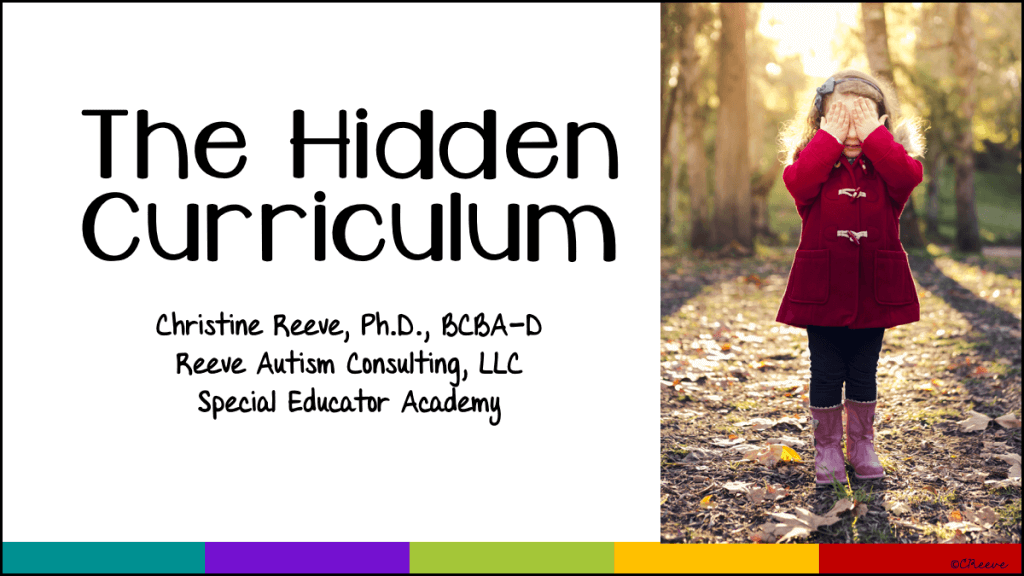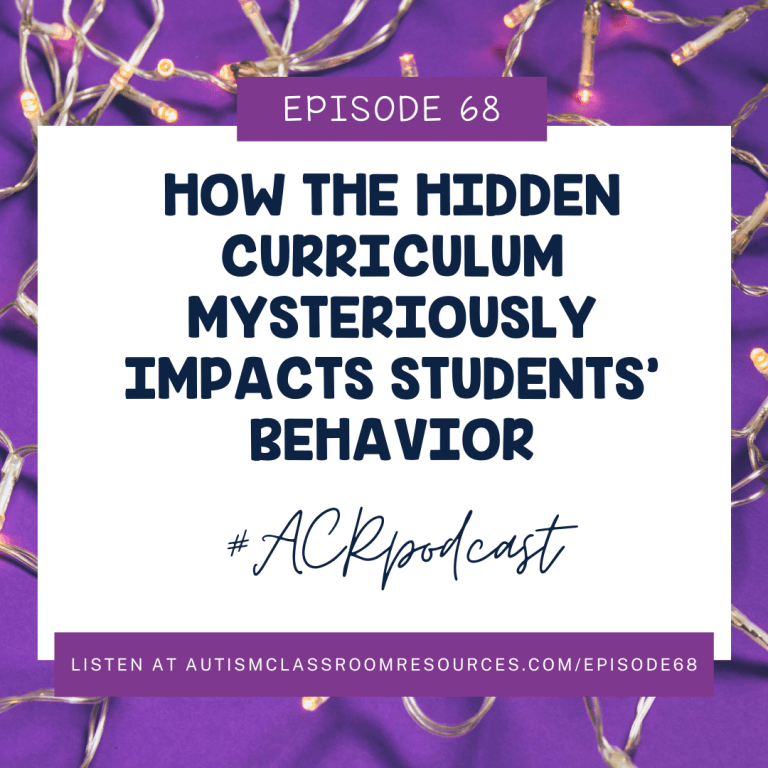For instance, when Mrs. QuietClass told Renaldo to stop talking to Jill, she didn’t typically say to the rest of the class….”And that goes for the rest of you too…there is no talking to your neighbor in my class.” At least she typically didn’t say that unless the behavior kept happening. But for students with autism, and learning disabilities and other disabilities, they often miss these cues. And while this isn’t a huge deal, it does frustrate their teachers and sometimes gets the student in trouble. And for a student who doesn’t understand the hidden curriculum, he has no idea why he is in trouble.
Episode 68 Highlights
I’ve written a whole series of blog posts about the hidden curriculum from what it is and what it means in autism and how to teach it. So I’m not going to focus on those here. But I will make sure that those links are in the blog post that goes with this episode at autismclassroomresources.com/episode68.
In this episode I want to focus on specifically how the hidden curriculum impacts students’ behavior. This relationship is particularly an issue for those who have the invisible disability that we’ve been talking about in this series that places them in situations with limited adult supervision. That’s primarily because their lack of understanding of the unspoken social context is often the reason they engage in behavior, like in Mrs. QuietClass’ situation.
So I’m going to outline some common areas in which the hidden curriculum impacts students’ behavior and some considerations we need to have in how we address the behavior. And I’ll point you to some posts and resources for that as well. So let’s get started.
How the Hidden Curriculum Impacts Behavior
One example I always use to know if you are dealing with the hidden curriculum is if you have ever said, “Why would you do that when I just told him not to?” Or if you’ve ever said, “What were you thinking?” Often these phrases follow behaviors that seemed obviously problematic to us (and probably to peers). But they don’t seem problematic to the student who completed them. Now, many of them will tell you, when asked, that they were wrong. Sometimes they realize it. Other times, they recognize that they are in trouble so they say they know better, even when they don’t. So let’s talk about some common situations in school when the hidden curriculum can impact students’ behavior. Obviously there are tons of example across the board, but these are some good ones to get started.
Interactions With Peers
Some of our students get into trouble with peers because they don’t recognize that there are things you should and shouldn’t say to other students. For instance, sometimes students with autism, in particular, are overly honest. Having been taught that honesty is the best policy and that lying is wrong, these students are strident about telling the truth. And that’s great. Until they look at the girls around the playground and go up to each one labeling each one “pretty” or “ugly.” If you understand that the student just says what he thinks and is always honest, you know where this came from. If you don’t, you may think he was intentionally being mean.
Sometimes it’s even more dangerous and more subtle. The hidden curriculum helps us figure out who is makes a good friend who cares about us and who does not. If we don’t explicitly teach our students about the qualities of a good friend, our students may become “friends” with students who purposely get them into trouble. These students may set them up to do things specifically to see them get into trouble because our students trusted them. Understanding the hidden curriculum item that a true friend wouldn’t ask you to do something he wouldn’t do himself is an important item to teach.
More Serious Interactions With Peers
Students who don’t understand the hidden curriculum don’t understand that there are things you might say with one group of people that shouldn’t be said with other groups. So, a prime example is a teenager who hangs out with the guys in the locker room. And he hears all the guys talk about how hot this young woman in their class is. He hears them use lots of sexualized language when talking about the young women in their classroom.
He wants to be friends with a girl in his class. So, modeling what he has heard in the locker room, he goes up and tells her how hot she is and uses lots of sexualized language to talk about her body. She gets extremely uncomfortable and upset and reports him to and adult (as she should) and he is likely to get suspended at best. It’s possible he could even have charges brought for sexual harassment. And he really wanted to do was say that he liked her and wanted to be friends with her. But he didn’t know that the way guys talk in the locker room is not the way to talk to girls.
Interactions With Teachers
I gave the example earlier of a minor example with Mrs. QuietClass’ frustration of students who talk to their neighbor. Here’s another example where I see many students get in trouble. In high school, in particular, the norms of classrooms start to shift and teachers have preferences for how they wish for students to participate in class. Some teachers appreciate students who call out in class and have lively discussions. Other teachers like to have a more orderly class where students are raising their hands and waiting to be called on.
Many of the students I have worked with have difficulty knowing the difference between these two expectations. And high school teachers don’t always explicitly state these expectations. They just expect that it will be clear as class progresses. And calling out once or twice in Mrs. Please Raiseyourhand’s classroom is probably not a big deal. Most students typically learn that means she doesn’t like that. But for students who aren’t in tune with the hidden curriculum, they don’t. And eventually the teacher gets frustrated with the student who keeps blurting out, and he becomes known as being disruptive. If it continues, he may be punished or even sent to the office. But because he’s been doing it all along in Mr. Lively Discussion’s classroom, he doesn’t get why he is in trouble.
What Can We Do About the Hidden Curriculum and Behavior?
So there are tons of examples of the impact of hidden curriculum on behavior. It can impact behavior on the job. It can huge impacts on behavior in places like school and public restrooms. Given that it can have such a big effect, it becomes something that we need to think about at two different levels.
Teach Proactively
First, we need to think about how we can prevent the hidden curriculum from impacting our students’ behavior. The way we do that is to teach it proactively.
One way to do that is to teach an item a day. There are a number of books that you can get (and I’ll link to them in the post below) with all different items to teach. And you can generate them on your own as well as you see them being needed.
You can also address them as problems arise and you see issues that need to be addressed. For some students this may happen more frequently than others. You can teach proactively as a group or individually. And then you can pool ideas from different students to make up your repertoire as well.
Teach Responsively
We also have to teach responsively. When we have a student, like the student who called girls pretty and ugly on the playground, we need to work with that student to understand what items of the hidden curriculum were missed. And then we need to address those to avoid having the same problem reoccurring.
Interpret Behavioral Incidents with the Hidden Curriculum in Mind
And most importantly, the thought I want to leave you with, is that we need to keep in mind the problems that these students have in interpreting the hidden curriculum when a behavioral incident occurs. I’ve been involved with many instances where this didn’t come to light until the manifestation determination. While it was clear at that point that it was a manifestation of their disability, the punishment had typically already been dealt. Sometimes it pays to do a little further investigation into understanding how the lack of social understanding of a situation might have played a role in a behavioral incident for these students rather than jumping to the interpretation of it being intentionally bad behavior.
More Information on the Hidden Curriculum
If you work with students with autism who struggle with understanding and learning the hidden curriculum, you might be interested to know we have a whole workshop on it in the Special Educator Academy as well as a whole course on teaching social skills and social understanding that ties into it. You can find out more about that and get a 7-day free trial at specialeducatoracademy.com.
I’ve included some links in the resources in the blog post (below) to learn more about all of this as well as strategies for addressing it. I’ve also included some books from my Amazon shop on teaching it that I think are particularly helpful. So you can find all of those resources on the podcast episode page at autismclassroomresources.com/episode68.
And I’d love to hear how you address the hidden curriculum in your classroom. So if you are an educator, hop over to the free facebook group at specialeducatorsconnection.com
Thanks so much for joining me today. I’ll be back next week with another episode. As always, thanks so much for everything you do for your students and I hope to see you then.







